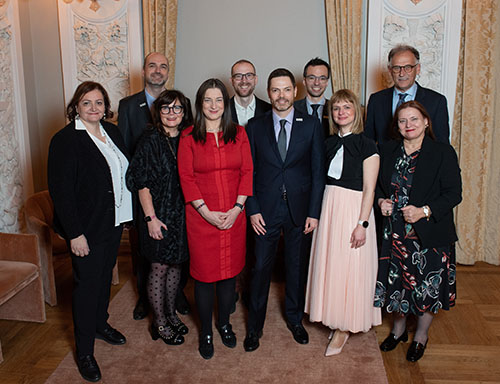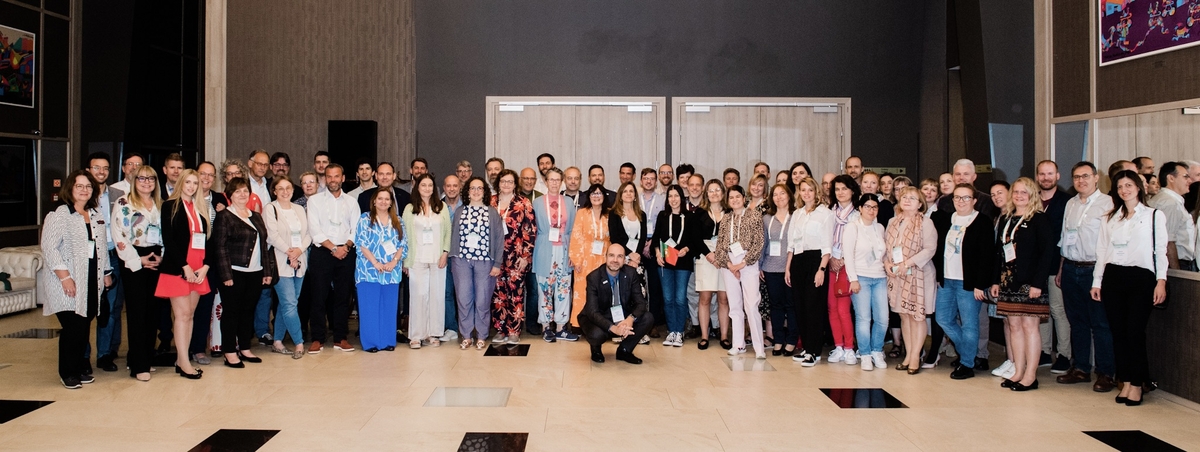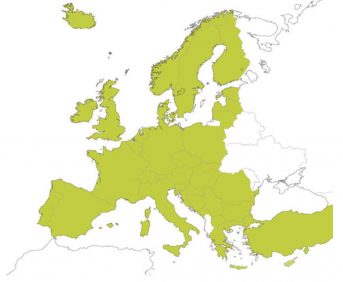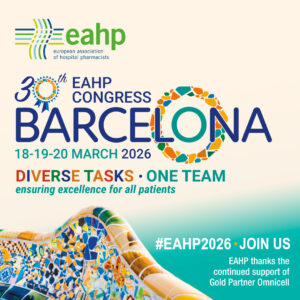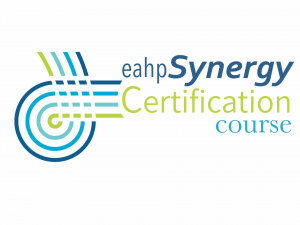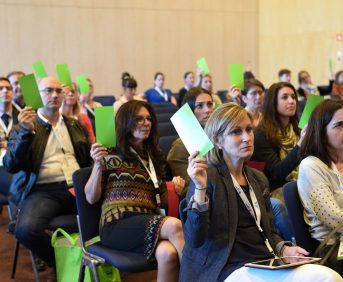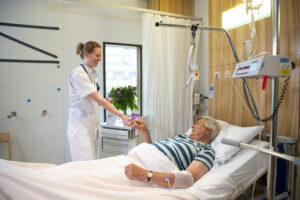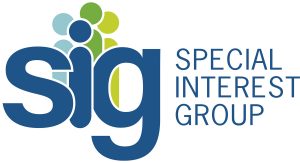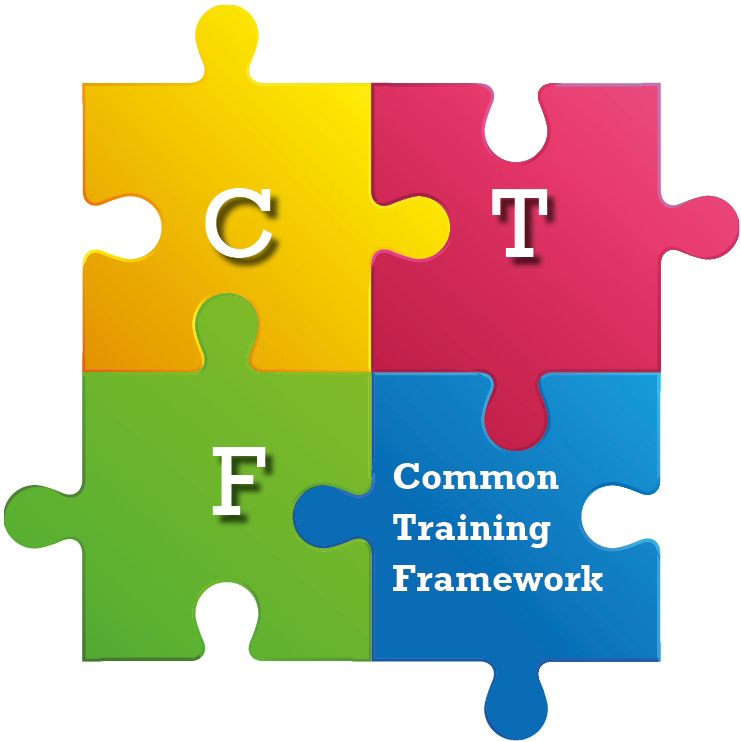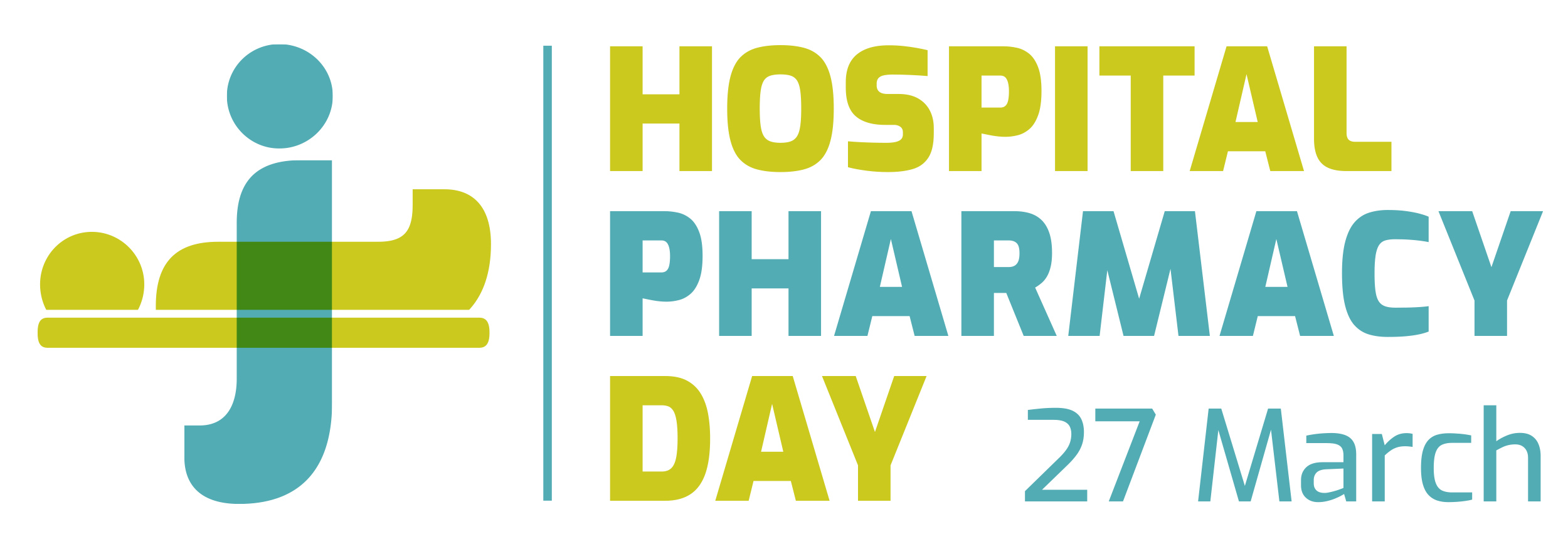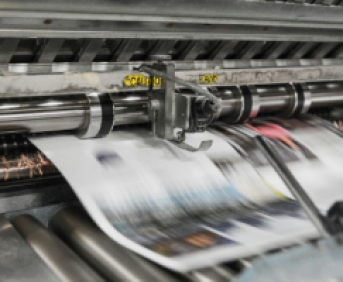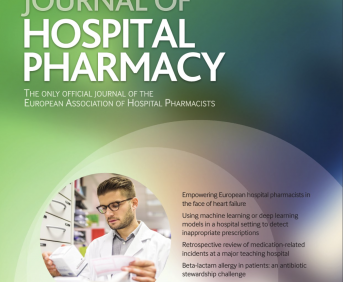ELECTRONIC RECORDING OF MEDICATION RECONCILIATION AS A RELIABLE REFERENCE FOR MULTIDISCIPLINARY CARE
Pdf

European Statement
Clinical Pharmacy Services
Author(s)
C. Bilbao Gómez-Martino, M.I. Borrego Hernando, A. Santiago Pérez, M.P. Pacheco Ramos, A.E. Arenaza Peña, L. Zamora Barrios, E. Rodríguez del Río, J.C. Tallón Martínez, Á. Nieto Sánchez, M.L. Arias Fernández
Why was it done?
MR has been proven to reduce medication errors at admission. If there are no electronic records of PCM, the information obtained by MR usually gets lost and could lead to repetition of errors.
What was done?
We provided electronic updated reports of patients’ current medications (PCM) after performing medication reconciliation (MR) at admission, although the electronic medical record (EMR) is not yet developed in our hospital.
How was it done?
The procedure, designed in the framework of a pilot MR programme, was gradually implemented in three hospitalisation units: internal medicine, geriatrics and oncology.
In order to make the medication reconciliation reports (MRR) reliable, the pharmacist consulted primary care prescriptions and at least two other independent sources of information, such as: emergency department’s admission report, previous clinical reports, self-reported medication list or the medication itself, if possible. The information was confirmed by a standardised clinical interview. Medication discrepancies were clarified by specific closed ended questions. The rest of treatment was investigated by open ended questions.
MRR included current chronic medication, relevant medications administered on demand, herbal medicines used for therapeutic purposes and other relevant data (inappropriate medications, interactions, dysphagia, adherence). Sources of information were also detailed.
MRR were integrated within the electronic hospitalisation reports, which were easily accessible via the hospital intranet.
At discharge, printed copies of reports were handled to patients.
What has been achieved?
99 MRR were recorded. 751 PCM were registered and 183 MR errors (MRE) were detected.
We contribute to the ‘best possible medication history’ of patients. This initiative might have improved patient safety by reducing discharge and readmission MRE, although it has not yet been measured.
We enhanced the pharmacist’s role in the multidisciplinary team.
What next?
This model of electronic MRR could become a useful reference for healthcare professionals, until the EMR is implemented. The next aim is to register MRR and all pharmaceutical care information in the EMR to improve our patients’ healthcare.
IMPLEMENTATION OF A PHARMACY TECHNICIAN COORDINATED MEDICATION SUPPLY SERVICE IN A PAEDIATRIC ELECTIVE TREATMENT CENTRE
European Statement
Selection, Procurement and Distribution
Why was it done?
PETC admits approximately 15 000 patients per year and is a high user of high cost drugs. Traditionally, a pharmacist provided a clinical and supply service with no technical support. Frequently, prescriptions were written late, dispensed items were lost and patients waited unnecessarily to receive treatment. Furthermore, patient non-attendance and medication re-supply due to misplacement of original dispensed items led to stockpiling of medicines.
What was done?
A pharmacy technician (PT) coordinated medication service was introduced onto the Paediatric Elective Treatment Centre (PETC) to decrease patient waiting time (PWT) and drug wastage.
How was it done?
Prior to admission, patients requiring medication were identified by a PT. If medication had been prescribed, this was transcribed onto a pharmacy order form. The prescription chart and order form were clinically checked by a pharmacist. If the drug had not been prescribed, prescribers were contacted. The medication was dispensed and delivered to the ward in advance. The PT ensured all required medication was readily available on the ward. Data on PWT, time to process medication orders, cost of unused drugs and number of items available prior to attendance were collected for a 6 month period.
What has been achieved?
Total cost savings achieved due to returned unused medication amounted to £82 074.
What next?
To extend the role of the PT in PETC. Therefore, the PT will undertake basic medication reconciliation, assessment of patients’ own drugs and notify the clinical pharmacist of patients requiring a full medication review.
DEVELOPMENT OF A 7 DAY CLINICAL PHARMACY SERVICE
Pdf

European Statement
Introductory Statements and Governance
Author(s)
S. Antoniou, M. Sullivan, P. Wright, J. Quinn
Why was it done?
The cardiac centre receives over 1800 acute admissions per year, with 20% of patients admitted on weekends. National reports highlight increased mortality at weekends, which has led to a call for the NHS to provide a consistent service throughout the week1. In accordance with the European statements of hospital pharmacy2, there was a need to ensure all prescriptions be reviewed and validated promptly on admission.
What was done?
Implementation of a 7 day clinical pharmacy service to a newly merged cardiac centre.
How was it done?
A successful business case for additional resources allowed for expansion of existing service to be delivered. This facilitated change in working hours for frontline staff, including provision of a shift system ensuring the EU working time directive3 was not exceeded. Expansion of the ward based pharmacy technicians’ role to include ward based dispensing led to timely access to medicines. An increase in the visibility of pharmacy staff at the ward level facilitated a patient facing clinical pharmacy service over the 7 days.
What has been achieved?
All new admissions and discharges are reviewed at weekends with visits to coronary and intensive care. Medicines reconciliation within 24 h is above 95%. 98% of discharge medication is supplied at ward level and 93% prepared prior to discharge prescription written. Feedback from patients, nursing and medical staff has been extremely positive.
What next?
The service is currently provided for patients admitted within the cardiac services. A review is underway to consider staffing requirements to implement the service across the whole site and the trust.
RENAL PHARMACIST OPTIMISES HEALTH OUTCOMES FOR PATIENTS
Pdf

European Statement
Introductory Statements and Governance
Author(s)
A. Frisch, D. Scharlemann-Moenks, K. Heinitz, R. Frontini
Why was it done?
Limited resources require optimisation of pharmacists’ interventions (EAHP Statement 1.3). Due to the limited number of clinical pharmacists (5/1350 beds) only a few wards were served by the pharmacy. We aimed to improve the effectiveness by covering selected patients in all wards and compared the results with a classic visit.
What was done?
Instead of visiting all patients in selected wards, pharmacists focused on patients with critical renal insufficiency across all wards.
How was it done?
The central laboratory identified patients as high risk when their glomerular filtration rates were <30 ml/min, and alerted the pharmacy via email. For those patients, the renal pharmacist analysed the prescribed medication at least twice weekly throughout their hospital stay for medication errors, dosing and interactions, and suggested alternatives where necessary. Interventions were discussed either directly with the doctors or by written advice. The major obstacle was the fact that clinical services by pharmacists were unknown in most wards and that some of the doctors were sceptical about the pharmacist`s competency. We overcame these obstacles by intensive collaboration with the nephrology department.
What has been achieved?
Over 20 months involving 4229 visits, the renal pharmacist analysed the medication of 2125 patients who had 11 different drugs on average. The pharmacist assessed 47 584 medications, resulting in 2900 interventions, of which 1292 were renal and 1608 other. The most common interventions for renal patients were dosage adjustments (20%), contraindications (16%) and interactions (10%). Overall, the number of interventions (6.1% of medication items) and their severity across all renal insufficiency patients exceeded those on the visceral surgical ward (2.4%) over the same time as a comparator, confirming the higher effectiveness of the intervention.
What next?
To conduct further studies on medication safety, we established a centre for drug therapy safety in collaboration with the faculty of pharmacy with the aim of discovering valid criteria for identifying other high risk patients.
High Performance Medicines Management – HPMMF
Pdf

European Statement
Introductory Statements and Governance
Author(s)
Lars-Åke Söderlund, Marie Olsson Nerfeldt , Birgitta Elfsson
Medication reviews conducted by clinical pharmacist in emergency ward
Pdf

European Statement
Clinical Pharmacy Services
What has been achieved?
.
CONTINUITY IN PERIOPERATIVE MEDICATION MANAGEMENT
Pdf

European Statement
Patient Safety and Quality Assurance
Author(s)
A. Navarro-Ruíz, C. Matoses-Chirivella, J.M. Del Moral-Sánchez, M. Morante, F.J. Rodríguez-Lucena, R. Gutiérrez-Vozmediano, A. Martínez-Valero, A. Andújar, E. García-Iranzo, A. Martí-LLorca
Why was it done?
There is evidence of discontinuity medication between different health care levels. In fact, on admission to hospital, up to one in two patients has an incomplete medicine list , resulting in a medicine not being administered during the hospital stay. This situation could be associated with an increased risk of hospital readmission or adverse drug reaction (ADR). Some studies show that an elevated percentage of surgical patients take medications prior to surgery, cardiac medications principally, but almost 50% of the drugs are omitted on the day of surgery.
What was done?
To develop a guideline to achieve the continuity of quality use of medicines between hospital and community in surgical patients.
How was it done?
The lack of medical evidence is reflected by the large variation in perioperative management recommendations among several group of experts. The recommendations in this guideline are to a large degree expert opinion, based on information from other reviews and textbooks, along with clinical experience. After a thorough review, the guide has obtained the consent of the Commission of pharmacy and therapeutics of the hospital.
What has been achieved?
The guide of conciliation of the medication includes a medication review structured according to the classification made by WHO ‘Anatomical, Therapeutic, Chemical classification system’. In each one of them, including the benefits and risks of continuing with this therapy during the perioperative process. It also includes various annexes, on antihypertensive, glucocorticoids and medicinal plants.
What next?
In the future, we would recommend prioritising the conciliation to the discharge with respect to other points of transition assistance, since the potential severity of an error of conciliation not intercepted the discharge of the patient is greater than if it occurs within the hospital.
A NATIONALLY COORDINATED APPROACH TO DEVELOPING HOSPITAL PHARMACY SERVICES IN DENMARK
European Statement
Introductory Statements and Governance
Why was it done?
Approximately 450 people work within clinical and ward pharmacy in hospitals in Denmark. Despite Denmark being a relatively small country, these services have developed at differing paces, and sometimes in different directions. The initiative was set up to coordinate development and innovation in this field, across the whole country.
What was done?
A national group was established to coordinate and develop clinical and ward pharmacy services throughout Denmark. The working group consists of pharmacists and pharmaconomists representing the eight hospital pharmacies in Denmark.
How was it done?
In 2012/2013 fifteen people representing pharmacists and pharmaconomists from the five Danish regions were selected to the working group. These people were typically known to be experienced drivers of innovation and development in the field of clinical and ward pharmacy. The working group meets quarterly and additional work is carried out between meetings. There are no extra resources available to members of the group or their workplaces.
What has been achieved?
The group has produced and implemented minimum standards for ward pharmacy across Denmark. Benchmarking has been carried out using these standards and the baseline has been set. Progress will be measured regularly.
New standards for how often medicine shelf-life checks should be carried out on wards have been developed, resulting in the task being carried out less frequently on most wards, thus releasing resources to more clinically related tasks, at a time where extra resources are scarce.
Two national networking days for pharmacists and pharmaconomists have been held, where good initiatives are shared to all the regions and hospital pharmacies in Denmark.
What next?
The group is working on national standards for competency development of clinical pharmacy staff. Other logistics tasks will be scrutinized to see whether resources can be found for further investment in clinically related activities.
More benchmarking will be carried out, measuring other clinical and ward pharmacy activities throughout Denmark.
The work has just begun!
IMPLEMENTING PHARMACIST PRESCRIBING AT SCALE ACROSS A UNITED KINGDOM NHS HOSPITAL TRUST
European Statement
Introductory Statements and Governance
Author(s)
D. Campbell, W. Baqir, O. Crehan, R. Murray, N. Wake, R. Copeland
Why was it done?
Supplementary prescribing was implemented as an attempt to reduce prescribing errors at the point of admission. Pharmacists working in more ‘traditional’ clinical roles would identify errors and then ask junior doctors to correct the mistakes made. Not only did this expose patients to unnecessary risks but this was an inefficient use of resources. Prescribing allowed pharmacists to work much more autonomously.
What was done?
Our initiative was to implement pharmacist prescribing across an NHS hospital trust. We focused on developing and using generalist prescribing pharmacists to enhance their current ward based role. We have adopted an “anytime, anywhere” approach to prescribing, where the prescribing pharmacist, like their medical counterparts, can prescribe any medicine, for any patient, for any condition and in any setting.
How was it done?
Pharmacist supplementary prescribing commenced on a single ward, with staff working within a care plan, managing patients. Independent prescribing allowed prescribing service to be rolled out across the Trust. We now expect all pharmacists to obtain a prescribing qualification as a condition of employment. The pace of development was very much dependent on the rate at which pharmacists could be trained.
What has been achieved?
Supplementary prescribing on the admissions unit showed 39% (127/326) of patients audited were prescribed medication that otherwise would have been omitted. In 2014, of the 49 pharmacists employed, 29 (59.2%) are actively prescribing, with seven also having specialist roles. Seven pharmacists (14.3%) are currently in training. An audit of prescribing showed that pharmacists prescribed for 40% (182/457) patients accounting for 13% (680/5279) of all items. In a separate audit, 4 (0.3%) errors from 1413 items prescribed were detected.
What next?
This process has become embedded across our Trust. Regionally, other Trusts agreed a workforce strategy which included the development and deployment of prescribing pharmacists in the way we have described above.
A TARGETED STRATEGY AND TRAINING PROGRAM TO IMPROVE THE MEDICATION RECONCILIATION PROCESS
European Statement
Clinical Pharmacy Services
Why was it done?
Medication reconciliation at admission was implemented in our hospital in 2011 and since then we could hardly meet the expectations of clinicians (completion of a Best Possible Medication History (BPMH) for 70% of patients in less than 24 hours). We also observed that the high patient volume decreased the quality of our BPMH completion process.
What was done?
We developed a strategy and an organisational thinking to remove human and technology barriers in performing medication reconciliation (MR). We designed a program to improve the overall quality of MR and increase the added value of MR for clinicians, nurses and pharmacists.
How was it done?
Our approach included four steps:
(1) “customer approach”; by conducting semi-structured interviews with students, clinicians and nurses to get their feedback, needs, expectations about medication reconciliation,
(2) literature review with Pubmed® and Embase®and benchmarking of other similar practices in France and Canada
(3) set a task force including pharmacists and students to define a strategy and metrics
(4) design solutions and assess them.
What has been achieved?
First, we defined and chose to target “High risk” admission inpatients only. Second, a training program based on two e-learning modules was implemented to develop skills of pharmacy students and residents. This program explores the “why” of conducting MR based on real life examples. It also defines the “what” (what is MR) and the “how” (i.e the different steps to run a MR and how to appropriately interact with the patient).
What next?
At each student rotation, the efficacy of the training program will be evaluated by comparing the concordance of BPMHs performed separately by a student and a pharmacist. A survey will be conducted to evaluate the level of learners’ satisfaction.
